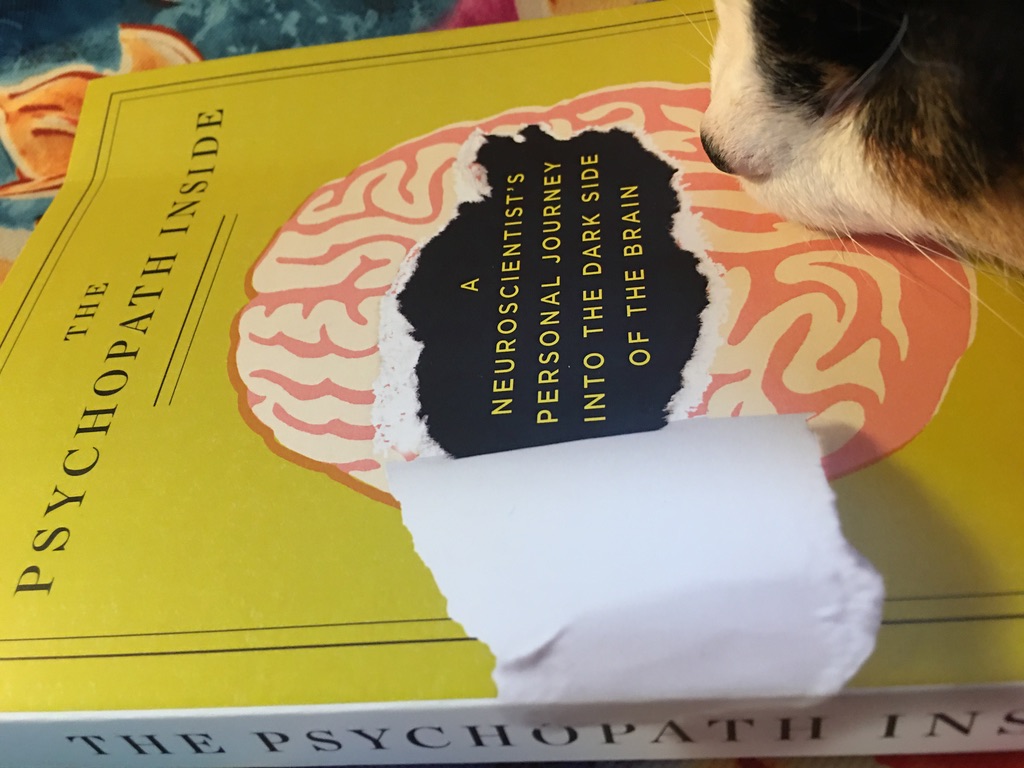Look A Book: The Psychopath Inside
Today is Wednesday May 19, 2021, and it’s a bit rainy. This past weekend, though, was sunny, a virtual mini-summer, so I got to hang out in my backyard, in my hammock, reading. This is the book, The Psychopath Inside by James Fallon. He’s a neuroscientist (and not to be confused with The Tonight Show’s Jimmy Fallon) .
.
Dr. Fallon studies brains. What makes them tick, or fail to tick correctly. What he’s most well-known for — in the eye of the general public — is his research on the brains of psychopaths. And, frankly, this research would not likely have caught the public eye except for one detail. Turns out, Dr. Fallon himself has the brain of a psychopath.
He found this out by accident. He was going through brain scans of his family, done to check for for a totally unrelated medical issue, when he saw this scan that looked just like it belonged in one of his other projects, the psychopath studies. He first thought that somehow the scans got mixed up and had his assistant check on it. But no, that was his. It came to find its way in the public eye because he brought it up in public venues, in his TED Talk in 2009, and his Moth Radio Hour story (recorded 2011, aired end of 2013). These attracted media attention and his story was repeated and amplified by media looking for intriguing stories, and he became the psychopath inside.
First, a bit on what makes a psychopath. Seems there is not a standard clinical definition, at least not as of the writing of this book in 2013. Characteristic traits include:
- emotional flatness and lack of empathy, lack of remorse, and refusal to accept responsibility for their actions
- superficiality, grandiosity, and deceitfulness
- impulsiveness and unreliability
- antisocial behavior such as hotheadedness, physical violence, pleasure in harming others, and sometimes a criminal record
There is a fair bit of science in the book, and I’m unlikely to remember most of the details. More interesting is what those details mean, such as activity detected in the dorsal part, or upper third, of the brain is associated more with rational thought, and activity in the ventral part, or lower third, of the brain is connected more with emotional intelligence. Seems that psychopath brains have far less activity, if any, in the ventral portion, and that manifests as a lack of emotional connection with others.
Still more interesting is Dr. Fallon’s reflection on the meaning of his brain’s state. He looks back on a warm upbringing and a loving family, wonderful childhood, teenage stuff, party years of college (and beyond), his fun-loving adventures and pranks that were all in jest and hurt nobody because his fellow participants wanted to let loose, and boys will be boys, right? Now, if you’ve been following me for a while, you probably know what I think of the phrase “boys will be boys” — a poor excuse to get away with poor behavior. Boys will be the boys we let them be, and the young James seems to have gotten away with a fair bit.
He didn’t identify himself as a psychopath for a while after his revealing brain scan, because according to him, he was missing some of the essential components of what he considered a true psychopath. He’s not physically violent. He doesn’t have a criminal record (which he mentions several times in the book), he doesn’t take pleasure in causing pain, and doesn’t try to cause pain (unless he’s out for revenge, which he notes briefly, towards the end, and gave no details). His writing oscillates between he’s just having fun and nobody got hurt, with thinking that maybe he hurt others and simply didn’t notice because it’s out of the realm of his personal experience due to his brain, or maybe at times he did hurt others but just didn’t care. That darned lack of empathy. Dr. Fallon goes back and forth, back and forth, about the impact of his actions. I don’t think he’s the right person to make that assessment, but as for others’ opinions, he probably does not care, as he states over and over and over again in this book. Which is what makes him the “psychopath inside.”
So how did family, friends, and colleagues relate to him after the publicity of his brain state? Well, he said a couple of “close” friends chose to limit or eliminate contact with him. Most already had him figured out, so nothing changed. And a small crowd actually wanted to spend more time with him. So next time you hear about those targeted and victimized by good boys (who went a little too far) get shoved to the side, especially if the perpetrator is relatively well-liked by others (even if they know what he’s about), wonder why no more. That’s the psychopath inside.
The book is an interesting read, even though Dr. Fallon is not a particularly artful writer, and his final chapter about why psychopaths are essential to a healthy society is verging on self-serving, in my opinion. If you personally have ever been in a relationship with a psychopath, sociopath, narcissist, or someone of that ilk, this book may bring back memories you may not relish reviewing, and in some cases could be triggering. Read at your own risk. Or read a book by Dr. Robert Hare instead.
Stay safe, live life.
